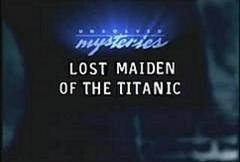
(The author would like to thank Dave Gittins for agreeing to appear as himself in this story.)

This is the transcript for one segment (titled “Lost Maiden of the Titanic“) of Episode 435 of “Unsolved Mysteries” on CBS, which aired on April 17, 1998.
(Fade from the opening credits to grainy footage of Titanic on its trial runs and moored at Southampton pier in preparation for its maiden voyage.)
Host Robert Stack (voiceover): It was said to be the largest moving object ever made in 1912. Standing on its stern, it stood taller than the tallest skyscraper at the time.
(Cut to a diagram of Titanic standing on its stern and measured against some notable tall structures of the day, then to illustrations of Titanic under construction, reducing the workers who built it to their proper perspective.)
Stack: Everything about the Titanic had to live up to its name. It had to have the biggest and best facilities of any ship for each of its three classes, and it did.
(Cut to the facilities for First, Second, and Third Class.)
Stack: Its First Class facilities rivaled that of the best hotels in the world. Its Second Class was equal to First Class on most other ships, while its Third Class passengers were afforded a higher standard of living than they could expect to receive back on land. However, such luxury would not be enjoyed for long, as the Titanic’s maiden voyage would also be its last.
(Cut to a clip from the 1958 movie, A Night to Remember, showing the moment Titanic struck the iceberg.)
Stack: Just before midnight on April 14, 1912, while on its way from Southampton, England to New York, it struck an iceberg in the North Atlantic. Two hours and 40 minutes later, it disappeared completely under the water. Over 2,200 people were on board the Titanic, but its lifeboats only had enough room for about half of them. Because of the chaos and panic that transpired aboard the doomed ship, only about 700 people were accommodated on the lifeboats before it went under, leaving some 1,500 people to brave the icy waters of the Atlantic and hope that rescue would soon arrive.
(Continue with footage from ANtR, showing passengers on the lifeboats staring mesmerized at the stern of Titanic pointing to the sky as it sank.)
Stack: Many of the lifeboats, which had rowed away from the epicenter of the sinking to avoid being sucked down by the Titanic, had room for more people, but only one boat returned to pick up survivors. By then, it was almost dawn, and of the 1,500 people who found themselves in the water that night, only six were still alive to be saved. The rest had frozen to death.
(Cut to pictures of the lifeboats with the survivors just before they board the Carpathia, followed by an image of the front page of the April 16, 1912 issue of the New York Times.)

Stack: The Titanic’s sinking shocked the world. Investigations into the disaster were made on both sides of the Atlantic, with accusations shot back and forth between the parties concerned. In an attempt to ensure that those who perished did not die in vain, the countries that plied the waters of the Atlantic agreed on new reforms for ocean travel, such as inaugurating an ice patrol and requiring enough lifeboats aboard their ships for everyone on board.
(Cut to a photo of Titanic’s sister ship, Olympic, outfitted with enough lifeboats for everyone. Stack appears on-screen in a cemetery setting at night.)
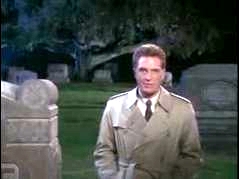
Stack: Eighty-six years have passed since the Titanic’s sinking, and it has become history’s most infamous shipwreck. Yet, many aspects of it continue to baffle researchers and enthusiasts today as they did in 1912. For example, the bodies of many of its victims were never identified or recovered, with most of the latter undoubtedly claimed by the elements and time. Hence, the circumstances of their deaths remain a mystery because their stories have been obscured by a lack of information or interest. One of these involves a First Class passenger by the name of Rose DeWitt Bukater. Not as famous as some other First Class women on the voyage, such as Madeleine Astor or Margaret Brown, Rose was easily forgotten in the maelstrom after the disaster. Furthermore, her body was never found. Two years ago, a woman from California came forward with an astonishing claim: she was Rose DeWitt Bukater. Her announcement was controversial, not least because of its similarity to the long-running Anastasia case. To attempt to settle this matter, a few researchers set out to probe deeper into Rose’s story in the hopes of reaching a better conclusion. What they found was that for a wealthy family, the Bukaters left behind remarkably few records, which were used by the production and research staff of “Unsolved Mysteries” to reconstruct Rose’s pre-Titanic life as best as possible.
(Cut to pictures of Rose as a little girl and that of her parents’ wedding.)

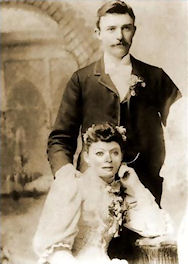
Stack (voiceover): Rose DeWitt Bukater was born in Philadelphia, Pennsylvania on April 5, 1895–the only child of Royce Tarleton and Ruth DeWitt Bukater. Fertility problems kept her mother from having more children. In spite of this, the family seemed a happy one. Both the Bukater and DeWitt families were stalwart members of Philadelphia high society. Royce was a businessman specializing in shipping and precious metals, while Ruth’s family fortune was made from textiles. Rose received the typical education for a daughter of wealth at the time–private tutors and governesses at home before being sent to finishing school at 15. According to her finishing school yearbook, she had four main interests: books, drama, art, and friends. One of her best friends happened to be her father.
(Cut to a picture of Rose reading with her father at home. Fade to a birthday card from Rose to her father.)
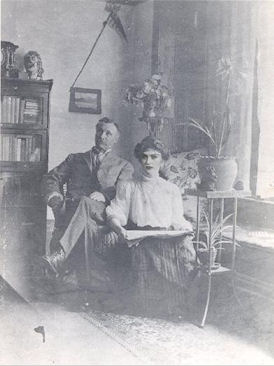
Stack: Royce tried hard to be a good father to Rose. But the additional tasks of overseeing his business interests and managing the family fortune took its toll on his health, which had always been feeble. Two weeks after his daughter graduated from finishing school, Royce collapsed and died of heart failure. Rose was devastated, having lost one of her closest companions. The tragedy also happened just two months before she was scheduled to make her societal debut.
(Cut to a re-enacted funeral for Royce, with Rose, Ruth, and other mourners in attendance.)
Stack: Now a widow, Ruth tried hard to maintain the family’s standing in society. They were in luck. Her daughter was noticed by a family even wealthier than the Bukaters–the Hockleys of Pittsburgh. Tycoon Nathan Hockley of the Hockley Steel Company had a son, Caledon, who was still single. They had attended Rose’s cotillion and caught sight of Rose, who had grown into an attractive young woman.
(Fade to a re-enacted debutante ball, with Caledon carefully admiring Rose from a distance. Cut to a re-enacted scene of the Hockleys meeting at the Bukater Home to discuss an engagement.)
Stack: The Hockleys formally introduced themselves to the Bukaters, and two months later, Rose was engaged to Caledon. Their wedding was set for May 1, 1912. Ruth and Rose’s future now looked secure. As an early birthday and prenuptial present to Rose, Nathan sent his son and the Bukaters on an all-expenses paid trip to Europe. They set sail from New York in March 1912 and visited Italy, France, and England.
(Fade to a photograph of the Heart of the Ocean.)
Stack: Among the gifts that Caledon bought in Europe for his fiancée was a very expensive piece of jewelry called Le Coeur de la Mer, or the Heart of the Ocean, a 56-karat blue diamond necklace. Moreover, the future bride and groom cut short their trip by a week to be among the first guests to sail aboard a steamer making its own debut–the Titanic.
(Cut to video footage of Rose preparing to board Titanic in Southampton.)
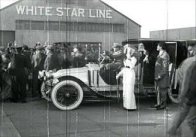


Stack: The White Star Line, which operated the Titanic, shot this video at Southampton pier on the morning of April 10, 1912 to commemorate the ship’s maiden voyage. Among the people captured in the 91-second clip was Rose, who stood out in a wide-brimmed hat and a white suit. She appeared to be excited about the trip. White Star had planned to show this video in theaters and nickelodeons on both sides of the Atlantic to promote the Titanic after it completed its initial journey to New York, but shelved the plan after the sinking. Only recently have Titanic scholars located this film after it had been sitting all but forgotten in a basement vault somewhere in London for over 80 years. It has been surprisingly well-preserved and contains the last known footage of Rose.
(Cut to shots of the interior of Suites B52, 54, and 56 and their private promenade area.)
Stack: On board, Caledon, the Bukaters, and their servants stayed in Suites B52, 54, and 56, nicknamed the “Millionaire Suites” because they were the most expensive rooms on the ship. They were originally allotted to J.P. Morgan, whose holding company controlled White Star. Morgan was also a business rival of the Hockleys through his control of U.S. Steel, but he agreed to rent his rooms to Caledon for a premium.
(Stack reappears on-screen.)
Stack: When the Titanic struck the iceberg on the evening of April 14, 1912, it was still some 1,200 miles from New York. The winter of 1912 had been quite warm, and the North Atlantic was infested with more icebergs than usual. Despite receiving several ice warnings, the Titanic’s Captain, Edward Smith, refused to slow down or chart a more southerly route. At some point during the sinking, Rose was separated from her mother and Caledon, both of whom survived. When her name failed to turn up on the survivors’ list, she was declared dead even in the absence of a body.
(Fade to a picture of Ruth followed by one of Caledon in later years.)


Stack (voiceover): The loss of her daughter and cancellation of the wedding devastated Ruth. She had hoped that Rose’s marriage to Caledon would preserve the Bukater name, even if it meant being dependent on the Hockleys. Not until after the sinking was it discovered that the Bukaters had been bankrupted by Royce’s poor business decisions and bad luck. In the end, part of Ruth’s wish was granted. What was left of the Bukater Estate became a subsidiary of the Hockley Empire, and Ruth lived through the grace of the Hockleys for the rest of her life. She became reclusive, aged rapidly, and died in 1922 just after her 50th birthday. Caledon filed an insurance claim for the Heart of the Ocean, which he lost in the sinking. He was compensated for his loss and married another woman. He continued to work under his father at Hockley Steel, which prospered during World War I, when there was an urgent need for shipping. Nathan died in 1924 and left the company to his son, who lacked his father’s business acumen. In addition, the Washington Naval Treaty of 1922 curtailed expenditures on military vessels, which deprived Hockley of a good portion of its revenue. A combination of lean times and fierce competition were too much for Caledon to handle. The stock market crash of 1929 ruined him, and Hockley Steel was acquired for a bargain by U.S. Steel. But Caledon did not live to see that, having committed suicide by the end of the year. He was 47.
(Cut to footage of Titanic’s wreck, followed by that of the Keldysh moored at sea.)


Stack: Since the Titanic’s wreck was discovered in 1985, a few researchers, enthusiasts, and treasure hunters have made the two-mile pilgrimage down to it. Among the treasure hunters is Brock Lovett, who had had success locating Spanish gold.
(Cut to an image of the real Brock Lovett, then to a re-enactor for Lovett examining Titanic’s deck plans aboard his vessel.)

Stack: When he heard about the Heart of the Ocean, Lovett saw it as his next, and biggest, challenge. After securing funding for his project, he hired the Russian research vessel, the Akademik Mstislav Keldysh, because it had two submersibles capable of diving down to the Titanic’s depth, after which he could deploy robotic vehicles to search inside the wreck. By 1996, three years into his quest, Lovett had nothing to show for his efforts except for a chest full of artifacts. His values were also questioned because he’d disturbed what was essentially a giant underwater tomb for personal gain.
(Cut to a CNN clip of Lovett talking with the anchor before it pans to a cropped version of the drawing on-screen.)
Anchor:Your expedition is at the center of a storm of controversy over salvage rights and even ethics. Many are calling you a grave robber.
Lovett:Well, nobody ever called the recovery of the artifacts from King Tut’s tomb grave robbing. I have museum-trained experts sent out here making sure that these relics are preserved and catalogued properly. Take a look at this drawing that we found just today: a piece of paper that’s been underwater for 84 years, and my team are able to preserve it intact.

Stack: On the other hand, among the artifacts contained in the chest was a drawing of a woman wearing nothing but a necklace resembling the Heart of the Ocean. The drawing was dated April 14, 1912 by someone with the initials, “JD,” and was shown on media outlets throughout the world. It sparked renewed public interest in the Titanic, the survivors of which had dwindled to a handful by that time.
(Cut to re-enactor for Lovett taking a call on his cell phone aboard the Keldysh.)
Stack: Right after the drawing was broadcast, Lovett was contacted by an elderly woman from California by the name of Rose Dawson Calvert. She claimed to be the woman in the drawing, and the woman in the drawing was none other than Rose DeWitt Bukater.
(Cut to re-enactors for Lovett and Calvert meeting face-to-face aboard the Keldysh.)
Stack: After Calvert conveyed certain information pertaining to the Heart of the Ocean that only someone with first-hand knowledge of the diamond would know, Lovett became convinced of her identity and invited her aboard the Keldysh, hoping that she could help him find the necklace. But not all of Lovett’s associates were as easily swayed.
(Lewis Bodine appears on-screen for an interview.)

Stack: Lewis Bodine, a Titanic historian who was present during Lovett’s interview of Calvert, recounts a conversation he had with Lovett before Calvert arrived on the Keldysh.
Bodine: I remember that meeting like it was yesterday. I told Brock I’d researched Calvert’s history all the way back to the 1920s, when she was still Rose Dawson. Before she married, she was a small-time actress in Hollywood, so that sent up a red flag. But Brock wasn’t waiting. I knew he was desperate because the money was about to run out, so he immediately arranged for Calvert to come aboard the Keldysh to tell her story, and I’m asking, “Are you sure about this? What if she’s like that Anastasia woman?” The similarities between the two were eerie, just as they were between Rose and the real Anastasia.
(Cut to a photograph of Rose before she sailed on Titanic with a caption stating that it was taken in February 1912. Shrink back this photograph to allow for one of Anastasia to be placed next to it. Slowly zoom in on both of their faces until they are visible only from the shoulder up.)
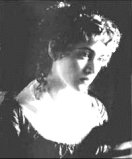
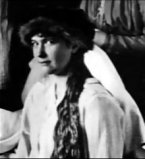
Stack: Indeed they were. Both Rose and Grand Duchess Anastasia Romanova of Russia were born into wealth and privilege. Both had strict mothers and more lenient fathers. Both were aspiring actresses. Both were believed to have died at the age of 17. The family fortunes of both took a drastic plunge a year before their assumed deaths. There was a remote possibility that each survived a calamitous event that was supposed to have taken her life. Each had at least one claimant to her identity, with Anastasia having several. In Anastasia’s case, her most prominent pretender claimed to have been rescued by a Bolshevik soldier after the Bolsheviks executed the former imperial family, while in Rose’s case, her alleged savior was a Third Class passenger named Jack Dawson. In neither case could the savior’s identity be confirmed.
(Cut to a re-enacted scene aboard the Keldysh with Calvert telling her story to Lovett and company. The information given by Calvert was composited by the UM transcript team from the recollections of those who were present on the Keldysh for her interview and provide a general idea of what she said.)
Re-enactor for Calvert: I was unhappy with my life and resolved to kill myself on the night of the 12th. I ran to the Titanic’s stern and was about to jump off when this Steerage man came up from behind me and told me to stop. He said his name was Jack Dawson from Chippewa Falls, Wisconsin. He convinced me to climb back over the railing, and I did. But I slipped before he caught my hand just in time.
(Cut back to Rose’s photograph, zooming in even closer on her melancholy eyes.)
Stack: Perhaps the most incredible part of Calvert’s story was that Rose was at the point of suicide before Jack saved her life. As a reward, Caledon invited Jack to a dinner in First Class on the evening of the 13th. Earlier that day, Rose confided to Jack her aversion to getting married. She felt comfortable talking to him. He had many of the same interests she did, such as a love for art and adventure. The conversation with Jack seemed to have given her a new lease on life, and by dinnertime, Rose had cheered up. Jack was even able to attend the dinner in style because First Class passenger Margaret Brown, whom he also purportedly met on board, had loaned him a tuxedo she had bought for her son.
(Cut to a picture of Margaret Brown before Titanic, followed by a re-enacted First Class dining scene. Re-enactor for Calvert reappears on-screen and continues with her tale.)
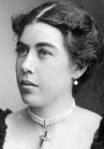
Re-enactor for Calvert: Cal invited Jack to dinner in First Class to embarrass him, but Jack carried himself like a gentleman, to the amazement of everyone except Mother and Cal. He said he won his ticket to the Titanic from a lucky hand at poker. After dinner, he took me to a party down in Steerage, and we had an even better time. I smoked, drank, and danced to my heart’s content, and hoped it would never end.
(Cut to a re-enacted scene on Titanic’s Boat Deck, where Rose and Jack talk and admire the sky. They are about to kiss before Rose abruptly returns to the First Class section.)
Stack: During the party in Titanic’s Third Class General Room, Rose found herself falling in love with Jack. They had known each other for exactly 24 hours. But since Rose was already engaged, she did not pursue this budding romance at the time.
(Cut to re-enactors for Caledon and Rose arguing during breakfast on April 14, 1912.)
Stack: The next morning, Caledon was angry with Rose for spending time with Jack after dinner rather than with him. An argument ensued, which ended with Caledon ordering Rose never to see Jack again.
Re-enactor for Caledon: Rose, you will never behave this way again!
Re-enactor for Rose: I am your fiancée, not some foreman in one of your mills.
(Caledon erupts, overturns a table, and intimidates Rose.)
Re-enactor for Caledon: You will honor me the way a wife is supposed to honor a husband! Is this in any way unclear?
Re-enactor for Rose: Y-yes.
(Caledon leaves the room, leaving Rose terrified. Bodine reappears on-screen.)
Bodine: Cal was the typical early 20th Century upper class male–vain, possessive, and always getting what he wanted. That was a turnoff for Rose. So along comes this Jack, who loved the simpler things in life. As far as Rose was concerned, he was her Prince Charming, and it didn’t matter that she was already engaged. So, on the last full day of Titanic’s sailing, Rose went back to Jack, despite her mother and Cal forbidding it. She then took him to her suite, where she posed for him wearing only the Heart of the Ocean while he drew her.
(Fade to a re-enacted scene on Titanic with Jack and Rose preparing to create the drawing Lovett would discover in 1996.)
Re-enactor for Rose: Draw me, Jack, wearing this diamond…wearing only this diamond.
Re-enactor for Jack: Okay, just lie down on the couch.
(Rose lies naked on a couch and is blocked by Jack from the neck down, but with the Heart of the Ocean visible. He finishes the drawing by autographing it with his initials. Bodine reappears on-screen.)
Bodine: If what Calvert said was true, then it’s clear what the initials “JD” stand for. It’s hard to imagine a girl of Rose’s stature posing nude for a portrait, but then, Rose seemed like she wanted to bust out of her restricted social role. After this, Cal sent his valet to look for her, and she and Jack led him on a wild chase around the ship before they lost him just above the boiler rooms. They made love inside a car in the cargo hold before returning upstairs to the forward deck, where they saw the iceberg hit.
(Cut to a computer model showing Titanic striking the iceberg.)

Bodine (voiceover): Then, Calvert said that Cal framed Jack by arranging for the Heart of the Ocean to “turn up” inside his coat pocket.
(Cut to re-enacted scene inside Caledon’s suite, with a steward finding the Heart of the Ocean in Jack’s coat pocket. Jack is arrested and taken away.)
Bodine: Jack was locked up below decks in the Master at Arms office, but Rose, who as a First Class woman had the best chance to board a lifeboat, instead went down there to free him as the ship was sinking. They made it back up to the Boat Deck, where Cal caught up with them.
(Cut to re-enacted scene of Rose going below decks to free Jack. Cal puts his jacket on Rose and convinces her to board a lifeboat. As the lifeboat is lowered halfway, Rose jumps back on Titanic and runs toward Jack.)
Bodine: It was cold, so he put his coat on Rose and tricked her into getting on a lifeboat by saying there’d be one for him and Jack. But Rose jumped back on the ship to be with Jack. That’s right; she gave up the security of a lifeboat seat twice to be with her new lover on the sinking Titanic.
(Cut to a re-enacted scene of Cal chasing Jack and Rose with a gun.)
Re-enactor for Jack: Run, Rose, run!
Bodine: Now Cal was really angry. He went after them with a gun, emptying the clip, but failed to hit them. He gave up and escaped on a lifeboat, but they remained on the ship until it had gone completely under.
(Fade to re-enacted scene of Rose climbing aboard a floating panel as Jack stays in the water.)
Bodine: Then, by a stroke of luck, they found a large piece of debris that Rose climbed on, saving her life. But it wasn’t big enough for two, so Jack remained in the water and froze to death. Rose was picked up by a lifeboat and arrived in New York aboard the Carpathia.
(Cut back to the re-enactment of Cal chasing Jack and Rose with a gun, but in slow motion.)
Stack: Did a female passenger abandon the safety of a lifeboat to jump back on the Titanic? Did a First Class male passenger fire a gun at his fellow passengers, one of whom was his fiancée, as the ship was sinking? Such events seemed bizarre and inappropriate for the moment, but is there any indication that they happened?
(Dave Gittins appears on-screen for an interview.)

Stack: Dave Gittins, a Titanic scholar from Australia, has been studying many aspects of the ship for two decades. His main interests are the nautical details of the sinking as well as the American and British Inquiries into it, with a secondary interest in Titanic’s lesser-known crew and passengers. His examination of the American Inquiry revealed that there were a couple of incidents that resembled the ones in Calvert’s account.
Gittins: During the 15th day of the American Inquiry on May 9, a passenger from Lifeboat 2, Mrs. Mahala Douglas, stated in an affidavit that she saw a female passenger jump from the boat back on Titanic, but things were so chaotic she didn’t know who it was. Earlier, on April 29, or the tenth day of the inquiry, a few First Class survivors reported hearing gunshots coming from the vicinity of the Grand Staircase about half an hour before Titanic went under completely. One of them claimed to have seen the shooter and his intended targets, the latter of whom were a man and a woman. When asked if he could identify any of these people, he said he couldn’t because everything had happened so quickly and he was more occupied with saving his own life. He did, however, notice that the shooter was dressed in black. Caledon was known to be wearing a black tuxedo on the night of April 14 and when he boarded the Carpathia. But you have to wonder if this witness told everything he knew because father and son likely went to work right away to ensure that the son wouldn’t have to answer for his crime, assuming he committed it.
(Cut to re-enactors for Caledon and Nathan conferring after Caledon arrived in New York.)
Gittins (voiceover): The Hockleys were known to use money and pressure to get what they wanted–the carrot and stick approach–so it wouldn’t be unreasonable to think they made any witness an offer he or she couldn’t refuse in exchange for not revealing anything incriminating. The fact that Harry Thaw came away with a light sentence six years earlier for murdering Stanford White and pleading insanity couldn’t have escaped them, so they had a legal precedent in their favor if Caledon ever had to stand trial.
(Bodine reappears on-screen.)
Bodine: The next question many would ask is: “Did Jack Dawson even exist?” Calvert said he was from Chippewa Falls, Wisconsin. He left home at 15 after his family died in a fire. We assumed he was probably in his twenties. An examination of old directories at the Chippewa Falls Library indicated there was a family called the Dawsons living in Chippewa Falls at the turn of the century, and yes, there were newspaper accounts of them being killed by fire in 1907. This could be Jack’s family, but we’re not certain because the records look incomplete and those available don’t list specific names. There are also no death or funeral records for the Dawsons in the city archives, and searches of tombstones in the cemeteries revealed nothing. Since it’s been so long, no resident of Chippewa Falls today can personally remember the Dawsons, and what they know of them from hearsay isn’t much. Still, if Rose really met up with Jack, you’d think maybe her mother, Cal, Molly Brown, or any of the other First Class passengers who dined with them on the evening of the 13th would have mentioned it in their future writings. But in the two years since Calvert’s story came out, we’ve still found absolutely nothing on Jack.
(Gittins reappears on-screen.)
Stack: Dave Gittins offers another theory for Jack’s undocumented presence on the ship: he might have gone by another name.
Gittins: The fact is there was no Jack Dawson on either the crew or passenger list. There was a crew member named Joseph Dawson on board, but he died in the sinking, was accounted for, and it’s unlikely he had much interaction with a First Class passenger. However, it wasn’t hard to board Titanic with someone else’s ticket because ID checks were much less stringent back then. That’s probably how Jack was able to travel around the world so easily–and with little or no documentation, since the U.S. didn’t have passport controls until World War I. So it’s very possible that he was officially known as another passenger on Titanic. But who? I had almost nothing to work with until one day I caught a lucky break. This was about two months after the drawing aired on TV. A man from the States disclosed in an early Titanic forum on the internet that his great-grandfather was scheduled to immigrate there on Titanic with his brother and two of his cousins, but he and his brother lost their tickets in a poker match to two men in a quayside pub just minutes before Titanic set sail. He believed one of the men was American, but forgot his name.
(Cut to re-enacted pub scene with Jack, the Gundersens, and Jack’s unidentified companion playing cards. Gittins reappears on-screen.)
Gittins: I was a member of this forum and managed to contact this man for an e-mail chat. He said his great-grandfather, whose name was Olaf Gundersen, loved to captivate his progeny on how he immigrated to America. Sure enough, Titanic’s passenger list had four men surnamed Gundersen. All were Steerage, and one of them was Olaf. Sadly, none was on the survivor list, so they all likely died in the sinking or didn’t make it on board to begin with if Olaf’s great-grandson is right. He said his great-grandfather and great-granduncle experienced a rash of bad luck in the hours before the sailing. First, they lost what little money they had to a swindle. Then, rather than cut their losses and board Titanic to start their lives anew in America, they tried to win back their money in a card game, using their tickets as collateral against two opponents who were just as eager to go to America. They lost the game and the tickets, and hence, were stuck in Southampton. But these misfortunes were blessings in disguise. When the Gundersens heard about the sinking, they must have felt like millionaires. Eventually, they were able to raise the money for another pair of tickets to the U.S., and they arrived in New York four months later. It’s an incredible story, and if it doesn’t prove Jack’s existence, it may point in that direction.
(Bodine reappears on-screen.)
Bodine: If Jack really won his ticket in a poker match, that would explain why his name never showed up on the passenger or survivor list. Ticket bearers back then didn’t have to produce any photo ID, so Jack could have traveled incognito on Titanic. Maybe he was a stowaway. As to why his body was never found, Calvert said that after he froze to death, his body sank under the water because he had no life jacket on. That probably meant Jack had no air left in him, so he sank like a stone. His body might have resurfaced later on, by which time the survivors would have been safely aboard the Carpathia bound for New York.
(Gittins reappears on-screen.)
Gittins: If Jack’s body didn’t remain at the bottom of the Atlantic, it’s possible that it resurfaced and then floated away to the south to be claimed by nature. A few bodies were known to have drifted as much as 160 nautical miles from the site of the sinking before they were discovered, by which time decomposition would have made identification nearly impossible. If Jack’s body was ever found, he was likely either buried in an unmarked grave in Halifax or at sea.
(Fade back to the drawing.)
Stack: So, the only pieces of evidence to indicate Jack’s existence were the drawing, a tale of a poker match, and Calvert’s word. The drawing is considered the most concrete proof because of the initials “JD”. The poker match was corroborated by two people, one of whom was Calvert. And Calvert’s story was the most extensive account of Jack’s conduct on the Titanic.
(Bodine reappears on-screen.)
Bodine: Everything seems to point back to Calvert, and only she knows for sure if she’s really Rose and if Jack existed. Unfortunately, she died on the Keldysh right after finishing her story.
(Stack reappears on-screen.)
Stack: Calvert died in the early hours of March 31, 1996, or five days before her 101st birthday. If she were really Rose DeWitt Bukater, then what became of her after the sinking and before she arrived in Hollywood? Presumably, she would have arrived in New York alone and penniless. How, then, did she survive during this time?
(Gittins reappears on-screen.)
Gittins: Let’s start with the moment Calvert, or Rose, was saved from the freezing water. She said she was picked up by Fifth Officer Harold Lowe in Lifeboat 14, the only lifeboat to actively return and look for survivors.
(Cut to a picture of Officer Lowe before returning to Gittins.)
Gittins: Official records indicate that Rhoda Abbott was the only woman saved from the water, but Lowe insisted he had picked up two women. In both the American and British Inquiries, he was asked about the people he rescued from the water. Two of them stood out. The first was a Chinese man whom he found floating on a piece of flotsam. The second was a “young lady” who signaled him with a whistle. Lowe remembered ordering everyone else on the boat to sit up to make room for this young lady and later Abbott to lie down. The young lady was definitely not Abbott, who was almost 40 at the time. Lowe even remembered offering this young lady a mug of tea aboard the Carpathia, but he never got her name.
(Cut to a picture of Abbott before returning to Gittins.)
Gittins: Lowe wrote a few letters after the sinking, but none of them mentioned Rose or anyone resembling her. Abbott, on the other hand, was a prolific writer who left behind a wealth of correspondence – a gold mine for Titanic scholars. In the years after the sinking until her death, she exchanged a good number of letters with Rose Dawson and later Rose Calvert. Perhaps the two first met on Lifeboat 14, in which case it’s clear who the young lady was. Still, none of Abbott’s correspondence with Rose proves that she was Rose DeWitt Bukater.
(Bodine reappears on-screen.)
Bodine: After Calvert died, we continued to dig into her past. It’s a known fact that her name on the survivor list was Rose Dawson, but before 1912, there was not a single record on Rose Dawson. There was also no record of a Rose Dawson having boarded Titanic at any port, so there are three possibilities for her existence: 1) she appeared out of thin air right after the sinking; 2) she traveled in the same manner as Jack; or 3) she went by another name when she boarded. It was easier to change one's identity in the days before drivers' licenses, Social Security numbers, and computerized record keeping, so Calvert lived in the right era.
(Gittins reappears on-screen.)
Gittins: Records indicate that Rose was given shelter by the Salvation Army once she arrived in New York. My father was a Salvo, and through him I learned quite a bit about the organization, so I think I could make a few educated guesses about Rose’s time with the Army. She probably stayed at its women’s shelter in Lower Manhattan. The Army was famous for its no smoking, no drinking policy, so Rose would have been discouraged from taking up either practice as long as she stayed with them, although that wouldn’t have prevented her from doing either outside the shelter. But she might have been inspired by the fact that the head of the Army in the States back then was a woman.
(Fade to a re-enacted scene of Rose accepting the Army’s offer of assistance after she disembarked at Pier 54 in New York before cutting to a picture of Evangeline Booth.)
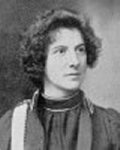
Gittins: Evangeline Booth was the daughter of the Army’s founders and headed its American operations for 30 years before she became its worldwide head. She was a strong leader with a charming personality, and she employed both qualities effectively when coordinating the Army’s relief efforts after the sinking. She personally greeted those survivors who sought Army help after they disembarked from the Carpathia on the evening of April 18, 1912, so she most likely encountered Rose. Another thing Rose would have liked about Booth was that she was a part-time actress who starred in Army plays to raise funds, and I wouldn’t be surprised if Rose began her acting career with the Army. But how long she stayed with the Army is unclear. Most of its records for the women’s shelter have been lost, and the shelter itself no longer exists today.
Bodine: Other than the Salvation Army records, we've found almost nothing on Calvert from her time in New York, when she was Rose Dawson. Not even a picture. I know she brought a bunch of pictures with her on board the Keldysh, but I didn’t have time to examine them. Now her granddaughter, Lizzy, has refused to let us take another look at them after her grandmother’s death. I’m sure pictures of Calvert from this period are in that collection. However, we’ve since had a chance to thoroughly examine the movies she appeared in, and it turns out that her Hollywood career began as early as 1918. She wasn’t given screen credits for her early films because of conflicts with the studios. So her films numbered about 30 in all, but none with a leading role, which meant she was not usually on-screen for long. The films are old and we haven’t been able to clean them up, so her image is grainy. But we were able to locate some pictures of her during her actress days, which we could clean up, and that’s not all. We also found a couple more snapshots of Rose before she sailed on Titanic!
(Fade to photos of Rose Dawson from 1918-1921.)
Stack (voiceover): These two pictures of Calvert were publicity photos taken between 1918 and 1921, when she was working in Hollywood as Rose Dawson.
(Shrink Dawson’s Hollywood photos to the right to include Rose’s pictures and the drawing.)





Stack: Next to them are pictures of Rose DeWitt Bukater and the woman in the drawing. The earliest and latest pictures were taken as much as a decade apart, but Dawson clearly bore a strong resemblance to the woman in the drawing and to Rose. The one on the extreme left was taken during her debutante ball and dated June 6, 1911. The one next to it was taken on April 4, 1912 in a Paris boutique, which is still around today.
(Fade to a re-enacted boutique scene showing the boutique owner finding Rose’s picture.)
Stack: One day, its present owner was clearing out some junk from its storage room when he discovered a pile of old records left behind by his predecessor. These included a register of past patrons going all the way back to the early 1900s. The former owner had preserved some valuable records, including a few for a certain “Mademoiselle Bukater,” who shopped for dresses here less than a week before the Titanic’s sailing, with a “Monsieur Hockley“ picking up the tab.
(Fade to a re-enacted boutique studio scene showing Rose having her picture taken.)
Stack: The boutique also doubled as a portrait studio so that patrons could request to have their pictures taken wearing their prospective outfits. Records showed that Rose purchased ten outfits from this boutique and took a total of 20 pictures. Each picture had two copies, with Rose receiving one set, which presumably went down with the Titanic.
(Bodine reappears on-screen.)
Bodine: There’s an amazing story behind each of Rose’s pictures. The one from her debutante ball was found inside a Mark Twain book that she donated to the University of Pennsylvania. According to UPenn, Rose had donated the book in her mother’s name, but the name couldn’t be revealed until 1922, by which time Rose was believed to be long dead and Ruth was about to die. Maybe Rose had slipped her picture into the book as a bookmark and forgot about it. She didn’t look too depressed in it, given that her father had died just three weeks earlier.
(Cut to re-enactor for Rose reading a book. She is called to another place, marks her page with the picture, and leaves the book behind. Bodine reappears on-screen.)
Bodine: As for the second picture, during World War II, the boutique survived the German occupation. After Paris was liberated, the Germans bombed it in retaliation. The city suffered only light damage, but the boutique was one of the worst hit, being damaged by fire. The owner risked his life to save what he could, but most records perished in the fire, including 19 of Rose’s 20 pictures. That means only one picture from both sets remains.
(Cut back to Rose’s boutique photo.)
Bodine (voiceover): The lone surviving picture shows her wearing a dark-colored gown looking sideways, so not all of her face is visible. But even from that angle, we could see some similarity between her, the woman in the drawing, and Calvert in her actress photos and movies. The publicity photos are the clearest images of her from this time.
(Bodine reappears on-screen using a computer to superimpose Rose’s June 1911 photo on one of Dawson’s 1918-1921 photos.)

Bodine: Now let’s try facial superimposition using one of Rose’s photos and one of Calvert’s actress photos. Here, their heads are positioned at the same angle, which allows me to align their facial features correctly. There’s a seven to ten-year interval between the two photos, but we can see that the eyes match almost perfectly. The eyes are the key. They tend to stay the same on a person’s face when everything else changes.
(Cut back to earlier picture of Ruth placed next to a picture of Calvert taken on the Keldysh.)

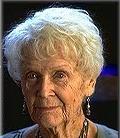
Bodine (voiceover): We also managed to get close-ups of Calvert on film when she was on the Keldysh. There is some resemblance between her and Ruth DeWitt Bukater shortly before each woman’s death, even though Calvert was twice Ruth’s age. But you have to remember that at the time of Ruth’s death, she looked older than her real age, while Calvert aged pretty gracefully.
(Bodine reappears on-screen.)
Bodine: So, after putting all these “sticks” together, we still have nothing that gives us a fire, but we do have a fair amount of smoke.
(Dr. Anatoly Milkailavich appears on-screen for an interview.)

Stack: There was one crew member of the Keldysh who got close enough for a good look at Calvert’s early post-Titanic pictures. Dr. Anatoly Milkailavich, the ship’s director and pilot of the submersibles that made the journeys down to the Titanic’s wreck, had entered Calvert’s room during her first night on board and engaged in a lengthy conversation with her.
Milkailavich (speaking Russian with English translation onscreen): On the evening of March 28, 1996, I brought some food to Mrs. Calvert after she had told part of her story to Mr. Lovett, who ordered that no one could talk to her in his absence because he was afraid that she might give information that would lead someone else to the diamond. Now that Lovett has retired, I can freely admit to having spoken to Calvert in private. I told Calvert I was not interested in the diamond; I was only curious about the similarities between her and Grand Duchess Anastasia of Russia. There was a woman who claimed for many years to be Anastasia, so for Calvert to say she was this Rose on Titanic was most coincidental. Calvert and I had a long and interesting conversation about Anastasia and the Romanovs, but I also had a good look at her pictures. I was immediately certain that she was the woman in the drawing, and if the woman in the drawing was Rose, then so was Calvert. After hearing her entire story and talking to her in private, I honestly do not think Calvert was lying or acting.
Stack: Aside from the pictures, there have been two other incidents of note that could possibly connect Calvert to Rose.
(Fade to a re-enacted scene of Ruth on her death bed in 1922, surrounded by a few people, one of them a woman whose face was not fully visible.)
Stack: In 1922, as Ruth lay dying in her bed in her Philadelphia home, she was visited by a strange woman one night. Caledon was not present, but Margaret Brown was, and of the people present in the house that evening, only Ruth, Margaret, and a third woman seemed to know this visitor’s identity. Another guest recalled that the visitor’s face was partly obscured by a hat, which she didn’t remove even after entering the house, as protocol dictated. She also might have been pregnant and said nothing, but Ruth granted her a private audience in her bedroom. Just before midnight, Ruth died, after which the visitor emerged from her bedroom in tears and was escorted out of the house by Margaret and the third woman. She was never seen again, not even showing up for Ruth’s funeral two days later despite seeming so devastated over her death.
(Fade to a re-enacted scene of Margaret on her death bed in 1932, also surrounded by a few people, including a family of five.)
Stack: Ten years later, Margaret herself lay dying in a New York hotel, and was visited by five mysterious guests this time–a man, woman, and three children who appeared to be a family. Margaret, arguably the most famous Titanic survivor who would posthumously be known as the “Unsinkable Molly Brown,” had suffered a series of strokes that left her nearly incapacitated, but mustered enough strength to greet the woman, who then introduced her to her husband and children. According to Margaret’s granddaughter, who was right beside them, the woman said her name was Rose.
(Bodine reappears on-screen.)
Bodine: Just when the truth appears to surface, it sinks back down into the depths. Was the Rose who went to see Molly Brown on her deathbed Rose Calvert? Was she also the woman who went to see Ruth? Brock and Lizzy might know, but since they’re now Mr. and Mrs. Lovett, they’ve been very reserved in discussing Calvert. I can’t blame them. Brock gave up almost everything to look for the diamond, including his first marriage, but in Lizzy, he found love again. Calvert’s story moved him so much that he retired from deep sea exploration. He was convinced that Calvert was Rose the moment he got on the phone with her, and her story only clinched it.
(Fade back to the previous pictures and video of Rose and the pictures of Dawson and Calvert presented in a medley.)
Stack: In the absence of irrefutable evidence proving that Calvert is Rose DeWitt Bukater, what do our consultants make of her claim?
(Milkailavich reappears on-screen.)
Milkailavich: As a scientist, I normally require the presence of hard evidence before I believe in something, but this is not a normal case; it’s an exceptional case. I have absolutely no doubt that Calvert was Rose. Those pictures, along with what she said in her story to Lovett and in her private meeting with me are enough to convince me of her authenticity. Besides, who says scientists can’t have faith? I have faith in Calvert and in Lovett, who is usually a good judge of people. If he believes Calvert is Rose, then so do I.
(Gittins reappears on-screen.)
Gittins: From what I know so far, I’m at least 80 – maybe even 90 – percent certain that Rose Calvert was Rose DeWitt Bukater, even without a DNA test. First of all, in her early pictures Calvert looked a lot like Rose. Yes, she was an actress, but even the best actress couldn’t have put on such a charade for over 80 years, nor could she have had such intimate knowledge of certain matters that were probably exclusive to the people who were directly involved in them. If she were some imposter who just happened to resemble Rose and decided to assume Rose’s life, then why didn’t she seek out Caledon right after the sinking and claim to be Rose? Most imposters are in it for the fame and money, but Calvert wasn’t. Even if she was, how much time would she have had to enjoy either? A DNA test would close the book on this case, but there are too many similarities between Rose and Calvert to be coincidences.
(Bodine reappears on-screen.)
Bodine: Rose was an aspiring actress and trained to put on a smiling face in finishing school, which would have served her well had she made it to Hollywood. Calvert was a trained actress, and as compelling as her story sounds, I need something more concrete before I’m convinced that she and Rose are one and the same. At least with that Anastasia imposter, the recent DNA test on her remains refuted her claim, but Lizzy has protected her grandmother’s legacy like a hermetic seal. We had someone from the maternal side of Rose’s family willing to compare his DNA to Calvert’s, but Lizzy isn’t cooperating. We can’t even get a strand of hair from her, and I can’t expect any help from Brock because he defers to his wife. A part of me says that Calvert is Rose, but the scholar in me says that without a DNA test, everything else is circumstantial. The only other way she’d convince me of her claim is if she’d showed Brock where to find the Heart of the Ocean. That’s what I can’t get over. Brock spent a bundle to secure the information on it, which was supposed to be airtight – until it wasn’t. And since there’s no record of the Heart being sold or pawned, it’s still out there somewhere. I’ll hold off on my verdict on Calvert, but I’ll admit that my pendulum has swung from total skepticism before I heard her story to about 50-50 right now – maybe 51-49 in favor.
(Stack reappears on-screen.)
Stack: The Lovetts turned down an invitation to be interviewed for “Unsolved Mysteries,” but Calvert’s granddaughter, Elizabeth, issued the following statement to be read in public:
(Cut to a magnified copy of Elizabeth’s letter, panning through some of the text and with a woman’s voice reading it word-for-word.)
My late grandmother, Rose Dawson Calvert, was an extraordinary woman who faced numerous challenges in the 101 years she was on this planet and overcame almost all of them. Her greatest ordeal might have been the sinking of the Titanic, but her greatest achievement was not surviving it. While the sinking took so much from her, including the first love of her life, it gave her the opportunity to live more fully and productively in the eight decades afterward until the day she passed away. That was what Rose DeWitt Bukater wanted, and no genetic evidence could prove that she lived her dream and established her legacy as well as the pictures of her experiences, which she kept close to her until the end, and the family she helped raise. I would like to thank everyone who has maintained an interest in my grandmother’s story, but as far as I’m concerned, this case has been settled.
(Stack reappears on-screen.)
Stack: For many people with at least a general interest in the Titanic, the story of Rose DeWitt Bukater has become something of a minor legend. Legends have always had a role in keeping otherwise obscure stories alive, but for some Titanic scholars, the legend surrounding Rose has helped ensure that she remains a frustrating enigma. Because it is now almost 90 years since the sinking, the chances of new evidence appearing to support or refute Rose Dawson Calvert’s claim to being Rose DeWitt Bukater are slim, and they become slimmer with each passing year. But maybe, just maybe, there is still someone or something somewhere holding the key to unlocking this mystery once and for all.
(Fade to 800 number screen.)
Stack (voiceover): If you have any information that could be helpful to solving the mystery of Rose DeWitt Bukater, please call the “Unsolved Mysteries” hotline at 1-800-876-5353.
(End credits roll.)
